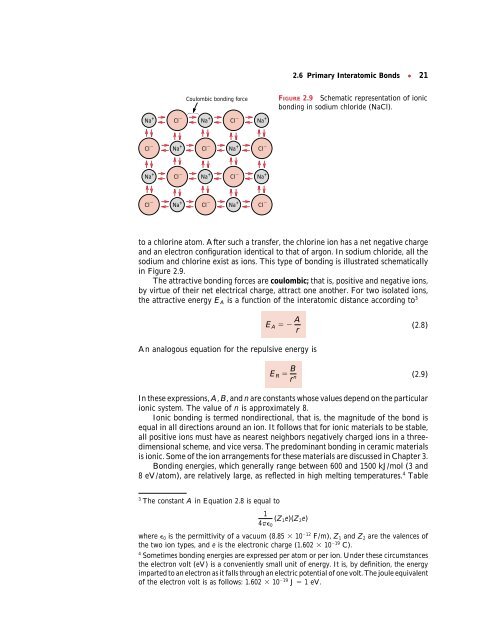Chapter 2 / Atomic Structure and Interatomic Bonding
Chapter 2 / Atomic Structure and Interatomic Bonding
Chapter 2 / Atomic Structure and Interatomic Bonding
Create successful ePaper yourself
Turn your PDF publications into a flip-book with our unique Google optimized e-Paper software.
Na +<br />
Cl <br />
Na +<br />
Cl <br />
Cl <br />
Na +<br />
Cl <br />
Na +<br />
Coulombic bonding force<br />
Na +<br />
Cl <br />
Na +<br />
Cl <br />
Cl <br />
Na +<br />
Cl <br />
Na +<br />
Na +<br />
Cl <br />
Na +<br />
Cl <br />
2.6 Primary <strong>Interatomic</strong> Bonds ● 21<br />
to a chlorine atom. After such a transfer, the chlorine ion has a net negative charge<br />
<strong>and</strong> an electron configuration identical to that of argon. In sodium chloride, all the<br />
sodium <strong>and</strong> chlorine exist as ions. This type of bonding is illustrated schematically<br />
in Figure 2.9.<br />
The attractive bonding forces are coulombic; that is, positive <strong>and</strong> negative ions,<br />
by virtue of their net electrical charge, attract one another. For two isolated ions,<br />
the attractive energy E A is a function of the interatomic distance according to 3<br />
E A A<br />
r<br />
An analogous equation for the repulsive energy is<br />
FIGURE 2.9 Schematic representation of ionic<br />
bonding in sodium chloride (NaCl).<br />
E R B<br />
r n<br />
(2.8)<br />
(2.9)<br />
In these expressions, A, B, <strong>and</strong> n are constants whose values depend on the particular<br />
ionic system. The value of n is approximately 8.<br />
Ionic bonding is termed nondirectional, that is, the magnitude of the bond is<br />
equal in all directions around an ion. It follows that for ionic materials to be stable,<br />
all positive ions must have as nearest neighbors negatively charged ions in a threedimensional<br />
scheme, <strong>and</strong> vice versa. The predominant bonding in ceramic materials<br />
is ionic. Some of the ion arrangements for these materials are discussed in <strong>Chapter</strong> 3.<br />
<strong>Bonding</strong> energies, which generally range between 600 <strong>and</strong> 1500 kJ/mol (3 <strong>and</strong><br />
8 eV/atom), are relatively large, as reflected in high melting temperatures. 4 Table<br />
3 The constant A in Equation 2.8 is equal to<br />
1<br />
(Z1e)(Z2e)<br />
40<br />
where 0 is the permittivity of a vacuum (8.85 10 12 F/m), Z1 <strong>and</strong> Z2 are the valences of<br />
the two ion types, <strong>and</strong> e is the electronic charge (1.602 10 19 C).<br />
4 Sometimes bonding energies are expressed per atom or per ion. Under these circumstances<br />
the electron volt (eV) is a conveniently small unit of energy. It is, by definition, the energy<br />
imparted to an electron as it falls through an electric potential of one volt. The joule equivalent<br />
of the electron volt is as follows: 1.602 10 19 J 1eV.



